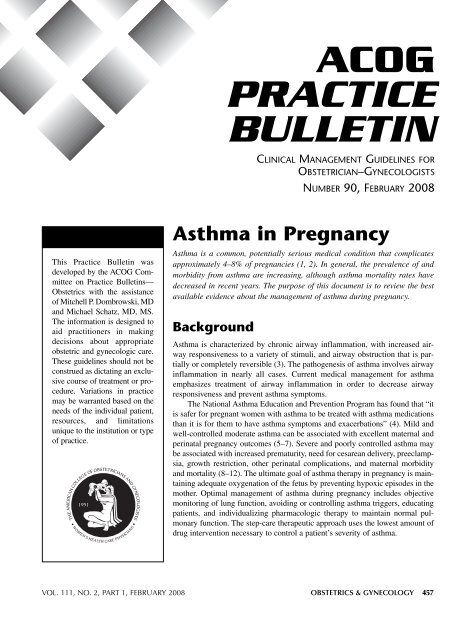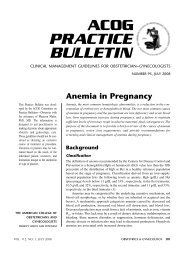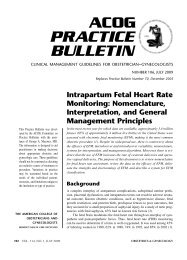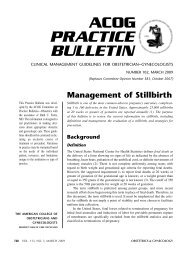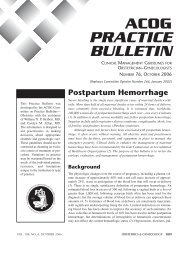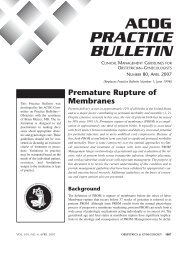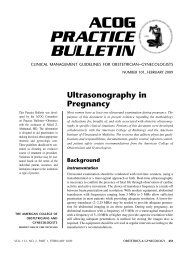ACOG Practice Bulletin No. 90: Asthma in Pregnancy
ACOG Practice Bulletin No. 90: Asthma in Pregnancy
ACOG Practice Bulletin No. 90: Asthma in Pregnancy
- No tags were found...
You also want an ePaper? Increase the reach of your titles
YUMPU automatically turns print PDFs into web optimized ePapers that Google loves.
<strong>ACOG</strong>PRACTICEBULLETINCLINICAL MANAGEMENT GUIDELINES FOROBSTETRICIAN–GYNECOLOGISTSNUMBER <strong>90</strong>, FEBRUARY 2008This <strong>Practice</strong> <strong>Bullet<strong>in</strong></strong> wasdeveloped by the <strong>ACOG</strong> Committeeon <strong>Practice</strong> <strong>Bullet<strong>in</strong></strong>s—Obstetrics with the assistanceof Mitchell P. Dombrowski, MDand Michael Schatz, MD, MS.The <strong>in</strong>formation is designed toaid practitioners <strong>in</strong> mak<strong>in</strong>gdecisions about appropriateobstetric and gynecologic care.These guidel<strong>in</strong>es should not beconstrued as dictat<strong>in</strong>g an exclusivecourse of treatment or procedure.Variations <strong>in</strong> practicemay be warranted based on theneeds of the <strong>in</strong>dividual patient,resources, and limitationsunique to the <strong>in</strong>stitution or typeof practice.<strong>Asthma</strong> <strong>in</strong> <strong>Pregnancy</strong><strong>Asthma</strong> is a common, potentially serious medical condition that complicatesapproximately 4–8% of pregnancies (1, 2). In general, the prevalence of andmorbidity from asthma are <strong>in</strong>creas<strong>in</strong>g, although asthma mortality rates havedecreased <strong>in</strong> recent years. The purpose of this document is to review the bestavailable evidence about the management of asthma dur<strong>in</strong>g pregnancy.Background<strong>Asthma</strong> is characterized by chronic airway <strong>in</strong>flammation, with <strong>in</strong>creased airwayresponsiveness to a variety of stimuli, and airway obstruction that is partiallyor completely reversible (3). The pathogenesis of asthma <strong>in</strong>volves airway<strong>in</strong>flammation <strong>in</strong> nearly all cases. Current medical management for asthmaemphasizes treatment of airway <strong>in</strong>flammation <strong>in</strong> order to decrease airwayresponsiveness and prevent asthma symptoms.The National <strong>Asthma</strong> Education and Prevention Program has found that “itis safer for pregnant women with asthma to be treated with asthma medicationsthan it is for them to have asthma symptoms and exacerbations” (4). Mild andwell-controlled moderate asthma can be associated with excellent maternal andper<strong>in</strong>atal pregnancy outcomes (5–7). Severe and poorly controlled asthma maybe associated with <strong>in</strong>creased prematurity, need for cesarean delivery, preeclampsia,growth restriction, other per<strong>in</strong>atal complications, and maternal morbidityand mortality (8–12). The ultimate goal of asthma therapy <strong>in</strong> pregnancy is ma<strong>in</strong>ta<strong>in</strong><strong>in</strong>gadequate oxygenation of the fetus by prevent<strong>in</strong>g hypoxic episodes <strong>in</strong> themother. Optimal management of asthma dur<strong>in</strong>g pregnancy <strong>in</strong>cludes objectivemonitor<strong>in</strong>g of lung function, avoid<strong>in</strong>g or controll<strong>in</strong>g asthma triggers, educat<strong>in</strong>gpatients, and <strong>in</strong>dividualiz<strong>in</strong>g pharmacologic therapy to ma<strong>in</strong>ta<strong>in</strong> normal pulmonaryfunction. The step-care therapeutic approach uses the lowest amount ofdrug <strong>in</strong>tervention necessary to control a patient’s severity of asthma.VOL. 111, NO. 2, PART 1, FEBRUARY 2008 OBSTETRICS & GYNECOLOGY 457
Medications<strong>Asthma</strong> medications generally are divided <strong>in</strong>to longtermcontrol medications and rescue therapy. Long-termcontrol medications are used for ma<strong>in</strong>tenance therapy toprevent asthma manifestations and <strong>in</strong>clude <strong>in</strong>haled corticosteroids,cromolyn, long-act<strong>in</strong>g β-agonists, and theophyll<strong>in</strong>e.Rescue therapy, most commonly <strong>in</strong>haledshort-act<strong>in</strong>g β-agonists, provides immediate relief ofsymptoms. Oral corticosteroids can either be used as aform of rescue therapy to treat an asthma exacerbation oras long-term control therapy for patients with severe persistentasthma.Certa<strong>in</strong> medications, possibly used dur<strong>in</strong>g labor anddelivery, have the potential to worsen asthma. <strong>No</strong>nselectiveβ-blockers, carboprost (15-methyl prostagland<strong>in</strong> F 2α)and ergonov<strong>in</strong>e may trigger bronchospasm. Magnesiumsulfate is a bronchodilator, but <strong>in</strong>domethac<strong>in</strong> can <strong>in</strong>ducebronchospasm <strong>in</strong> patients who are sensitive to aspir<strong>in</strong>.Prostagland<strong>in</strong> E 2or prostagland<strong>in</strong> E 1can be used for cervicalripen<strong>in</strong>g, the management of spontaneous or<strong>in</strong>duced abortions, or the management of postpartumhemorrhage (13).<strong>Asthma</strong> Severity ClassificationIn 2004, the National <strong>Asthma</strong> Education and PreventionProgram Work<strong>in</strong>g Group on <strong>Asthma</strong> and <strong>Pregnancy</strong>def<strong>in</strong>ed mild <strong>in</strong>termittent, mild persistent, moderate persistent,and severe persistent asthma accord<strong>in</strong>g to daytimeand nighttime symptoms (wheez<strong>in</strong>g, cough<strong>in</strong>g, ordyspnea) and objective tests of pulmonary function (4).The most commonly used pulmonary function parametersare the peak expiratory flow rate (PEFR) andforced expiratory volume <strong>in</strong> the first second of expiration(FEV 1). Current National <strong>Asthma</strong> Education andPrevention Program guidel<strong>in</strong>es suggest classify<strong>in</strong>g thedegree of asthma severity <strong>in</strong> patients who are not tak<strong>in</strong>gcontroller medication and the degree of asthma control <strong>in</strong>patients who are tak<strong>in</strong>g controller medication (Table 1).Effects of <strong>Pregnancy</strong> on <strong>Asthma</strong>In a large prospective study, pregnant patients with mildasthma had exacerbation rates of 12.6% and hospitalizationrates of 2.3%, those with moderate asthma had exacerbationrates of 25.7% and hospitalization rates of6.8%, and those with severe asthma had exacerbationrates of 51.9% and hospitalization rates of 26.9% (14).The effects of pregnancy on the course of asthma arevariable—the symptoms of 23% of women studiedimproved and the symptoms of 30% became worse dur<strong>in</strong>gpregnancy (14). Because many pregnant womenhave <strong>in</strong>creased symptoms, pregnant patients who haveasthma, even those with mild or well-controlled disease,need to be monitored with PEFR and FEV 1test<strong>in</strong>g aswell as by observ<strong>in</strong>g their symptoms dur<strong>in</strong>g pregnancy.Effects of <strong>Asthma</strong> on Pregnant Womenand FetusesThere has been considerable consistency among resultsof prospective studies of the effects of asthma dur<strong>in</strong>gpregnancy. Eight prospective studies, report<strong>in</strong>g maternaland <strong>in</strong>fant outcomes with at least 100 participants <strong>in</strong>locations at or near sea level, have been published (5–7,15–20). These studies show that the gravid patient withmild or moderate asthma can have excellent maternaland <strong>in</strong>fant outcomes. However, suboptimal control ofasthma dur<strong>in</strong>g pregnancy may be associated with<strong>in</strong>creased maternal or fetal risk (7). In fact, a significantrelationship has been reported between decreased FEV 1dur<strong>in</strong>g pregnancy and <strong>in</strong>creased risk of low birth weightand prematurity (21). Results of the two largest studiesTable 1. Classification of <strong>Asthma</strong> Severity and Control <strong>in</strong> Pregnant PatientsFEV 1or Peak Flow<strong>Asthma</strong> Severity* Interference With (Predicted Percentage(Control † ) Symptom Frequency Nighttime Awaken<strong>in</strong>g <strong>No</strong>rmal Activity of Personal Best)Intermittent 2 days per week or less Twice per month or less <strong>No</strong>ne More than 80%(well controlled)Mild persistent More than 2 days per week, More than twice per month M<strong>in</strong>or limitation More than 80%(not well controlled) but not dailyModerate persistent Daily symptoms More than once per week Some limitation 60–80%(not well controlled)Severe persistent Throughout the day Four times per week or more Extremely limited Less than 60%(very poorly controlled)Abbreviation: FEV 1, forced expiratory volume <strong>in</strong> the first second of expiration*Assess severity for patients who are not tak<strong>in</strong>g long-term-control medications.† Assess control <strong>in</strong> patients tak<strong>in</strong>g long-term-control medications to determ<strong>in</strong>e whether step-up therapy, step-down therapy, or no change <strong>in</strong> therapy is <strong>in</strong>dicated.458 <strong>ACOG</strong> <strong>Practice</strong> <strong>Bullet<strong>in</strong></strong> <strong>Asthma</strong> <strong>in</strong> <strong>Pregnancy</strong> OBSTETRICS & GYNECOLOGY
<strong>in</strong>dicate that classification of asthma severity and therapytailored accord<strong>in</strong>g to asthma severity can result <strong>in</strong>excellent <strong>in</strong>fant and maternal outcomes (6, 7).There are important caveats when <strong>in</strong>terpret<strong>in</strong>g thestudy results of asthma <strong>in</strong> pregnancy. Fewer considerableadverse associations have been found <strong>in</strong> the results ofprospective studies, possibly because of better asthmasurveillance and treatment. The excellent maternal and<strong>in</strong>fant outcomes were achieved at centers that tended tomanage asthma <strong>in</strong> pregnancy actively. In addition, womenwho enroll <strong>in</strong> research studies tend to be more motivatedand adhere to therapeutic regimens more than the generalpublic. The lack of more adverse outcomes amongwomen with severe asthma also may be a function of therelatively small number of participants <strong>in</strong> this cohort andthe result<strong>in</strong>g lack of power to f<strong>in</strong>d adverse outcomes thatwere statistically significant. Although the results of theseprospective studies are reassur<strong>in</strong>g <strong>in</strong> their consensus ofgood pregnancy outcomes, they do not <strong>in</strong>dicate that asthmashould be considered a benign condition because activeasthma management was a part of these studies and mayhave had a positive impact on the outcomes.Cl<strong>in</strong>ical Considerations andRecommendationsHow is asthma diagnosed dur<strong>in</strong>g pregnancy?Diagnosis of asthma <strong>in</strong> a pregnant patient is the same asthat for a nonpregnant patient. <strong>Asthma</strong> typically <strong>in</strong>cludescharacteristic symptoms (wheez<strong>in</strong>g, chest cough, shortnessof breath, chest tightness), temporal relationships(fluctuat<strong>in</strong>g <strong>in</strong>tensity, worse at night), and triggers (eg,allergens, exercise, <strong>in</strong>fections). Wheez<strong>in</strong>g on auscultationwould support the diagnosis, but its absence doesnot exclude the diagnosis. Ideally, the diagnosis of asthmawould be confirmed by demonstrat<strong>in</strong>g airway obstructionon spirometry that is at least partially reversible(greater than a 12% <strong>in</strong>crease <strong>in</strong> FEV 1after bronchodilator).However, reversible airway obstruction may not bedemonstrable <strong>in</strong> some patients with asthma. In patientswith a cl<strong>in</strong>ical picture consistent with asthma, <strong>in</strong> whomreversible airway obstruction cannot be demonstrated, atrial of asthma therapy is reasonable. In such patients, apositive response to asthma therapy can be used to diagnoseasthma dur<strong>in</strong>g pregnancy.In patients present<strong>in</strong>g with new respiratory symptomsdur<strong>in</strong>g pregnancy, the most common differentialdiagnosis would be dyspnea of pregnancy. Dyspnea ofpregnancy usually can be differentiated from asthma byits lack of cough, wheez<strong>in</strong>g, chest tightness, or airwayobstruction. Other differential diagnoses <strong>in</strong>clude gastroesophagealreflux, chronic cough from postnasal drip, andbronchitis.How should patients with asthma be assesseddur<strong>in</strong>g pregnancy?Cl<strong>in</strong>ical evaluation <strong>in</strong>cludes subjective assessments andpulmonary function tests. Because pulmonary functionand asthma severity may change dur<strong>in</strong>g the course ofpregnancy, rout<strong>in</strong>e evaluation of pulmonary function <strong>in</strong>pregnant women with persistent asthma is recommended.For pulmonary function assessment dur<strong>in</strong>g outpatient visits,spirometry is preferable, but peak expiratory flowmeasurement with a peak flow meter also is sufficient.Patients with worsen<strong>in</strong>g symptoms should be evaluatedwith peak flow measurement and lung auscultation.Severity and control of asthma should be assessed <strong>in</strong>terms of symptom exacerbation and pulmonary impairment.It is important to identify a history of prior hospitalization(especially hospital stays that required <strong>in</strong>tensivecare unit admission or <strong>in</strong>tubation), emergency departmentor other unscheduled visits for asthma treatment, or oralcorticosteroid requirements. In patients who are not tak<strong>in</strong>gcontrollers, it is useful to assess pulmonary impairmentbased on severity classification (Table 1). Patientswith two or more episodes of symptom exacerbationrequir<strong>in</strong>g the use of oral corticosteroids <strong>in</strong> the prior12 months also should be considered to have persistentasthma. In patients who are tak<strong>in</strong>g controllers, it is usefulto assess control (Table 1). Assess<strong>in</strong>g the impairmentdoma<strong>in</strong> of control consists of determ<strong>in</strong><strong>in</strong>g the frequencyof daytime symptoms, nocturnal symptoms, activity limitation,frequency of rescue therapy, and FEV 1. Theassessment <strong>in</strong> a pregnant patient with asthma also should<strong>in</strong>clude the effect of any prior pregnancies on asthmaseverity or control because this may predict the course ofthe asthma dur<strong>in</strong>g subsequent pregnancies.Can allergy shots be started or cont<strong>in</strong>ueddur<strong>in</strong>g pregnancy?The use of allergen immunotherapy, or “allergy shots,”has been shown to be effective <strong>in</strong> improv<strong>in</strong>g asthma <strong>in</strong>patients with allergies (4). In two studies, no adverseeffects of immunotherapy dur<strong>in</strong>g pregnancy have beenfound (22, 23). However, anaphylaxis is a risk of allergen<strong>in</strong>jections, especially early <strong>in</strong> the course ofimmunotherapy when the dose is be<strong>in</strong>g escalated, andanaphylaxis dur<strong>in</strong>g pregnancy has been associated withmaternal death, fetal death, or both. In a patient who isreceiv<strong>in</strong>g a ma<strong>in</strong>tenance or near-ma<strong>in</strong>tenance dose, notexperienc<strong>in</strong>g adverse reactions to the <strong>in</strong>jections andapparently deriv<strong>in</strong>g cl<strong>in</strong>ical benefit, cont<strong>in</strong>uation ofimmunotherapy is recommended. In such patients, aVOL. 111, NO. 2, PART 1, FEBRUARY 2008 <strong>ACOG</strong> <strong>Practice</strong> <strong>Bullet<strong>in</strong></strong> <strong>Asthma</strong> <strong>in</strong> <strong>Pregnancy</strong> 459
dose reduction may be considered to further decrease thechance of anaphylaxis. Risk–benefit considerations donot usually favor beg<strong>in</strong>n<strong>in</strong>g allergen immunotherapydur<strong>in</strong>g pregnancy.What is appropriate rescue therapy for asthmadur<strong>in</strong>g pregnancy?Inhaled short-act<strong>in</strong>g β 2-agonists are the rescue therapy ofchoice for asthma dur<strong>in</strong>g pregnancy. Inhaled albuterol isthe first-choice, short-act<strong>in</strong>g β 2-agonist for pregnantwomen, although other agents also may be appropriate.In general, patients should use up to two treatments of<strong>in</strong>haled albuterol (two to six puffs) or nebulized albuterolat 20-m<strong>in</strong>ute <strong>in</strong>tervals for most mild to moderate symptoms;higher doses can be used for severe symptom exacerbation.To avoid maternal and fetal hypoxia, patientsshould be counseled to start rescue therapy at home whenthey have an exacerbation of symptoms, such as cough<strong>in</strong>g,chest tightness, dyspnea, wheez<strong>in</strong>g, or a 20% decrease<strong>in</strong> the PEFR. With a good response (ie, symptoms reduceor resolve, and the PEFR reaches 80% of personal best)the patient can cont<strong>in</strong>ue normal activity. If the patientdoes not have a good response or if she notices adecrease <strong>in</strong> fetal activity, she should seek medical attentionquickly.What is first-l<strong>in</strong>e controller therapy for asthmadur<strong>in</strong>g pregnancy?For those with mild, <strong>in</strong>termittent asthma, no controllertherapy is <strong>in</strong>dicated. Use of <strong>in</strong>haled corticosteroids is firstl<strong>in</strong>econtroller therapy for persistent asthma dur<strong>in</strong>g pregnancy.For patients with mild, persistent asthma, the use oflow-dose <strong>in</strong>haled corticosteroids is recommended (see thebox). For patients with moderate persistent asthma orwhose symptoms are not controlled with the use of lowdose<strong>in</strong>haled corticosteroids, the use of medium-dose<strong>in</strong>haled corticosteroids or low-dose <strong>in</strong>haled corticosteroidsand long-act<strong>in</strong>g β-agonists are <strong>in</strong>dicated. SeeTable 2 for typical <strong>in</strong>haled corticosteroid regimens.Budesonide is the preferred <strong>in</strong>haled corticosteroid for usedur<strong>in</strong>g pregnancy (4). However, there are no data <strong>in</strong>dicat<strong>in</strong>gthat the other <strong>in</strong>haled corticosteroid preparations areunsafe dur<strong>in</strong>g pregnancy. Therefore, the use of any <strong>in</strong>haledcorticosteroids may be cont<strong>in</strong>ued <strong>in</strong> patients whose asthmawas well controlled by these agents before pregnancy (4).What is appropriate add-on controller therapyfor asthma dur<strong>in</strong>g pregnancy?Use of long-act<strong>in</strong>g β 2-agonists is the preferred add-oncontroller therapy for asthma dur<strong>in</strong>g pregnancy. Thistherapy should be added when patients’ symptoms areStep Therapy Medical Managementof <strong>Asthma</strong> Dur<strong>in</strong>g <strong>Pregnancy</strong>Mild Intermittent <strong>Asthma</strong>• <strong>No</strong> daily medications, albuterol as neededMild Persistent <strong>Asthma</strong>• Preferred—Low-dose <strong>in</strong>haled corticosteroid• Alternative—Cromolyn, leukotriene receptor antagonist,or theophyll<strong>in</strong>e (serum level 5–12 mcg/mL)Moderate Persistent <strong>Asthma</strong>• Preferred—Low-dose <strong>in</strong>haled corticosteroid andsalmeterol or medium-dose <strong>in</strong>haled corticosteroidor (if needed) medium-dose <strong>in</strong>haled corticosteroidand salmeterol• Alternative—Low-dose or (if needed) mediumdose<strong>in</strong>haled corticosteroid and either leukotrienereceptor antagonist or theophyll<strong>in</strong>e (serum level5–12 mcg/mL)Severe Persistent <strong>Asthma</strong>• Preferred—High-dose <strong>in</strong>haled corticosteroid andsalmeterol and (if needed) oral corticosteroid• Alternative—High-dose <strong>in</strong>haled corticosteroid andtheophyll<strong>in</strong>e (serum level 5–12 mcg/mL) and oralcorticosteroid if needednot controlled with the use of medium-dose <strong>in</strong>haled corticosteroids.Alternative add-on therapies are theophyll<strong>in</strong>eor leukotriene receptor antagonists (montelukast, zafirlukast).However, the use of long-act<strong>in</strong>g <strong>in</strong>haled β 2-agonistsis preferred because it has been shown to be a moreeffective add-on therapy <strong>in</strong> nonpregnant patients thanleukotriene receptor antagonists or theophyll<strong>in</strong>e. Longact<strong>in</strong>g<strong>in</strong>haled β 2-agonists have fewer side effects thantheophyll<strong>in</strong>e, which has a narrow therapeutic <strong>in</strong>dex andrequires serum monitor<strong>in</strong>g, and there are few data on theuse of leukotriene receptor antagonists <strong>in</strong> humans dur<strong>in</strong>gpregnancy. See Table 2 for typical medication dosages.Because long-act<strong>in</strong>g and short-act<strong>in</strong>g <strong>in</strong>haled β 2-agonistshave similar pharmacology and toxicology, long-act<strong>in</strong>g<strong>in</strong>haled β 2-agonists are expected to have a safety profilesimilar to that of albuterol. Two long-act<strong>in</strong>g <strong>in</strong>haledβ 2-agonists are available: 1) salmeterol and 2) formoterol.Limited observational data exist on their use dur<strong>in</strong>g pregnancy.A step-wise approach to management is advised <strong>in</strong>order to achieve control. See the box for specific therapy.For patients whose symptoms are not well controlled(Table 1) with the use of medium-dose <strong>in</strong>haled corticosteroidsand long-act<strong>in</strong>g <strong>in</strong>haled β 2-agonists, treatmentshould be advanced to high-dose <strong>in</strong>haled corticosteroids460 <strong>ACOG</strong> <strong>Practice</strong> <strong>Bullet<strong>in</strong></strong> <strong>Asthma</strong> <strong>in</strong> <strong>Pregnancy</strong> OBSTETRICS & GYNECOLOGY
Table 2. Comparative Daily Doses for Inhaled Corticosteroids*Corticosteroid Amount Low Dose Medium Dose High DoseBeclomethasone HFA 40 mcg per puff 2–6 puffs More than 6–12 puffs More than 12 puffs80 mcg per puff 1–3 puffs More than 3–6 puffs More than 6 puffsBudesonide 200 mcg per <strong>in</strong>halation 1–3 puffs More than 3–6 puffs More than 6 puffsFlunisolide 250 mcg per puff 2–4 puffs 4–8 puffs More than 8 puffsFluticasone HFA 44 mcg per puff 2–6 puffs110 mcg per puff 2 puffs 2–4 puffs More than 4 puffs220 mcg per puff 1–2 puffs More than 2 puffsFluticasone DPI 50 mcg per <strong>in</strong>halation 2–6 puffs100 mcg per <strong>in</strong>halation 1–3 puffs 3–5 puffs More than 5 puffs250 mcg per <strong>in</strong>halation 1 puff 2 puffs More than 2 puffsMometasone 200 mcg per <strong>in</strong>halation 1 puff 2 puffs More than 2 puffsTriamc<strong>in</strong>olone 75 mcg per puff 4–10 puffs 10–20 puffs More than 20 puffs*Total daily puffs is usually divided <strong>in</strong>to a twice-per-day regimen.Abbreviations: DPI, dry powder <strong>in</strong>haler; HFA, hydrofluoroalkaneAdapted from National Heart, Lung, and Blood Institute, National <strong>Asthma</strong> Education and Prevention Program. Expert panel report 3: guidel<strong>in</strong>esfor the diagnosis and management of asthma. NIH Publication <strong>No</strong>. 07-4051. Bethesda (MD): NHLBI; 2007. Available at:http://www.nhlbi.nih.gov/guidel<strong>in</strong>es/asthma/asthgdln.htm. Retrieved September 10, 2007.(Table 2) and long-act<strong>in</strong>g <strong>in</strong>haled β 2-agonists (salmeterol,one puff twice daily). Some patients with severe asthmamay require regular oral corticosteroid use to achieve adequateasthma control. For patients whose symptoms arevery poorly controlled (Table 1), a course of oral corticosteroidsmay be necessary to atta<strong>in</strong> control, along with astep up <strong>in</strong> therapy, as described previously and <strong>in</strong> the box.What nonpharmacologic approaches shouldbe used for asthma dur<strong>in</strong>g pregnancy?Identify<strong>in</strong>g and controll<strong>in</strong>g or avoid<strong>in</strong>g factors, such asallergens and irritants, that contribute to asthma severity,particularly tobacco smoke, can lead to improved maternalwell-be<strong>in</strong>g with less need for medication (4). If gastroesophagealreflux is exacerbat<strong>in</strong>g the patient’s asthma,nonpharmacologic measures, such as elevat<strong>in</strong>g the headof the bed, eat<strong>in</strong>g smaller meals, not eat<strong>in</strong>g with<strong>in</strong> 2–3hours of bedtime, and avoid<strong>in</strong>g trigger<strong>in</strong>g foods, mayhelp. <strong>Asthma</strong> control is enhanced by ensur<strong>in</strong>g access toeducation about asthma, the <strong>in</strong>terrelationships betweenasthma and pregnancy, and the skills necessary to manageasthma. These skills <strong>in</strong>clude self-monitor<strong>in</strong>g, correctuse of <strong>in</strong>halers, follow<strong>in</strong>g a plan for long-term managementof asthma, and promptly handl<strong>in</strong>g signs of worsen<strong>in</strong>gasthma (4). Specific measures to reduce mold, dustmite exposure, animal dander, cockroaches, and otherenvironmental triggers may be important. Animal dandercontrol entails remov<strong>in</strong>g the animal from the home or, ata m<strong>in</strong>imum, keep<strong>in</strong>g the animal out of the patient’s bedroom.Cockroaches can be controlled by poison or baittraps and elim<strong>in</strong>at<strong>in</strong>g exposed food or garbage.How should asthma therapy be adjusteddur<strong>in</strong>g pregnancy?The step-care therapeutic approach <strong>in</strong>creases the numberand dosage of medications with <strong>in</strong>creas<strong>in</strong>g asthma severity(see the box). At each step of therapy, medications areconsidered to be “preferred” or “alternative” based onefficacy and safety considerations. Patients whose symptomsare not optimally respond<strong>in</strong>g to treatment shouldreceive a step up <strong>in</strong> treatment to more <strong>in</strong>tensive medicaltherapy. Once control is achieved and susta<strong>in</strong>ed for severalmonths, a step-down approach can be considered, buta change <strong>in</strong> therapy should be undertaken cautiously andadm<strong>in</strong>istered gradually to avoid compromis<strong>in</strong>g the stabilityof the asthma control. For some patients, it may be prudentto postpone, until after birth, a reduction of therapythat is effectively controll<strong>in</strong>g the patient’s asthma (4).How should acute asthma be assessed dur<strong>in</strong>gpregnancy?Initial assessment of a pregnant patient present<strong>in</strong>g withacute asthma <strong>in</strong>cludes obta<strong>in</strong><strong>in</strong>g a brief medical history,perform<strong>in</strong>g a physical exam<strong>in</strong>ation, and exam<strong>in</strong><strong>in</strong>g physiologicmeasures of airway function and fetal well-be<strong>in</strong>g.Pulmonary physiologic assessment <strong>in</strong>cludes measur<strong>in</strong>gFEV 1or PEFR and oxygen saturation. Fetal assessmentVOL. 111, NO. 2, PART 1, FEBRUARY 2008 <strong>ACOG</strong> <strong>Practice</strong> <strong>Bullet<strong>in</strong></strong> <strong>Asthma</strong> <strong>in</strong> <strong>Pregnancy</strong> 461
depends on the stage of pregnancy, but cont<strong>in</strong>uous electronicfetal monitor<strong>in</strong>g or biophysical profile or bothshould be considered if the pregnancy has reached thestage of fetal viability.After <strong>in</strong>itial treatment, repeat assessments of thepatient and fetus will determ<strong>in</strong>e the need for cont<strong>in</strong>u<strong>in</strong>gcare. Patients with FEV 1or PEFR measurements greaterthan or equal to 70% susta<strong>in</strong>ed for 60 m<strong>in</strong>utes after lasttreatment, no distress, and reassur<strong>in</strong>g fetal status may bedischarged. For an <strong>in</strong>complete response (FEV 1or PEFRmeasurements greater than or equal to 50% but less than70%, mild or moderate symptoms), the disposition (cont<strong>in</strong>uedtreatment <strong>in</strong> the emergency department, dischargehome, or hospitalization) will need to be <strong>in</strong>dividualized.For patients with a poor response (FEV 1or PEFR measurementsless than 50%), hospitalization is <strong>in</strong>dicated. Forpatients with a poor response and severe symptoms, drows<strong>in</strong>ess,confusion, or PCO 2level greater than 42 mm Hg,<strong>in</strong>tensive care unit admission is <strong>in</strong>dicated and <strong>in</strong>tubationshould be strongly considered.What should be the discharge regimen afteran acute asthma episode?Patients discharged after an acute asthmatic episodeshould cont<strong>in</strong>ue treatment with short-act<strong>in</strong>g β 2-agonists,two to four puffs every 3–4 hours as needed. Oral corticosteroidsshould be cont<strong>in</strong>ued at a dose of 40–60 mg <strong>in</strong>a s<strong>in</strong>gle dose or two divided doses for 3–10 days. Inhaledcorticosteroids should be <strong>in</strong>itiated or cont<strong>in</strong>ued untilreview at medical follow-up. Outpatient follow-upshould be arranged with<strong>in</strong> 5 days of the acute visit.What are considerations for fetal surveillance<strong>in</strong> pregnancies complicated by asthma?Ultrasound exam<strong>in</strong>ations and antenatal fetal test<strong>in</strong>gshould be considered for women who have moderate orsevere asthma dur<strong>in</strong>g pregnancy. First-trimester ultrasounddat<strong>in</strong>g should be performed, if possible, to facilitatesubsequent evaluations of fetal growth restriction and therisk of preterm birth. Serial ultrasound exam<strong>in</strong>ations tomonitor fetal activity and growth should be considered(start<strong>in</strong>g at 32 weeks of gestation) for women who havepoorly controlled asthma or moderate-to-severe asthmaand for women recover<strong>in</strong>g from a severe asthma exacerbation.All patients should be <strong>in</strong>structed to be attentive tofetal activity.What <strong>in</strong>trapartum concerns are unique topregnant women with asthma?<strong>Asthma</strong> medication use should not be discont<strong>in</strong>ued dur<strong>in</strong>glabor and delivery. The patient should be kept hydratedand should receive adequate analgesia <strong>in</strong> order todecrease the risk of bronchospasm. Women who are currentlyreceiv<strong>in</strong>g or recently have taken systemic corticosteroidsshould receive <strong>in</strong>travenous adm<strong>in</strong>istrationof corticosteroids (eg, hydrocortisone 100 mg every8 hours) dur<strong>in</strong>g labor and for 24 hours after delivery toprevent adrenal crisis (4).Cesarean delivery for acute exacerbation of asthmais rarely needed. Maternal and fetal compromise usuallywill respond to aggressive medical management.However, delivery may benefit the respiratory status of apatient with unstable asthma who has a mature fetus.Lumbar anesthesia can reduce oxygen consumption andm<strong>in</strong>ute ventilation dur<strong>in</strong>g labor (24). Regional anesthesiawas reported to <strong>in</strong>cur a 2% <strong>in</strong>cidence of bronchospasm(25). Obstetric, anesthetic, and pediatric staffshould communicate to coord<strong>in</strong>ate <strong>in</strong>trapartum and postpartumcare.How should women with asthma be counseledabout breastfeed<strong>in</strong>g?In general, only small amounts of asthma medicationsenter breast milk. The National <strong>Asthma</strong> Education andPrevention Program found that the use of prednisone,theophyll<strong>in</strong>e, antihistam<strong>in</strong>es, <strong>in</strong>haled corticosteroids,β 2-agonists, and cromolyn is not contra<strong>in</strong>dicated forbreastfeed<strong>in</strong>g (4, 26).Summary ofRecommendations andConclusionsThe follow<strong>in</strong>g recommendations and conclusionsare based on limited or <strong>in</strong>consistent scientific evidence(Level B):It is safer for pregnant women with asthma to betreated with asthma medications than it is for themto have asthma symptoms and exacerbations.Cl<strong>in</strong>ical evaluation of asthma <strong>in</strong>cludes subjectiveassessments and pulmonary function tests.The ultimate goal of asthma therapy <strong>in</strong> pregnancy isma<strong>in</strong>ta<strong>in</strong><strong>in</strong>g adequate oxygenation of the fetus byprevent<strong>in</strong>g hypoxic episodes <strong>in</strong> the mother.The step-care therapeutic approach <strong>in</strong>creases thenumber and dosage of medications with <strong>in</strong>creas<strong>in</strong>gasthma severity.Inhaled corticosteroids are first-l<strong>in</strong>e controller therapyfor persistent asthma dur<strong>in</strong>g pregnancy.462 <strong>ACOG</strong> <strong>Practice</strong> <strong>Bullet<strong>in</strong></strong> <strong>Asthma</strong> <strong>in</strong> <strong>Pregnancy</strong> OBSTETRICS & GYNECOLOGY
Budesonide is the preferred <strong>in</strong>haled corticosteroidfor use dur<strong>in</strong>g pregnancy.Inhaled albuterol is recommended rescue therapyfor pregnant women with asthma.Identify<strong>in</strong>g and controll<strong>in</strong>g or avoid<strong>in</strong>g factors suchas allergens and irritants, particularly tobaccosmoke, can lead to improved maternal well-be<strong>in</strong>gwith less need for medication.Cont<strong>in</strong>uation of immunotherapy is recommended <strong>in</strong>patients who are at or near a ma<strong>in</strong>tenance dose, notexperienc<strong>in</strong>g adverse reactions to the <strong>in</strong>jections, andapparently deriv<strong>in</strong>g cl<strong>in</strong>ical benefit.Use of prednisone, theophyll<strong>in</strong>e, antihistam<strong>in</strong>es,<strong>in</strong>haled corticosteroids, β 2-agonists, and cromolynis not contra<strong>in</strong>dicated for breastfeed<strong>in</strong>g.The follow<strong>in</strong>g recommendations and conclusionsare based primarily on consensus and expert op<strong>in</strong>ion(Level C):<strong>Asthma</strong> self-management skills, <strong>in</strong>clud<strong>in</strong>g selfmonitor<strong>in</strong>g,correct use of <strong>in</strong>halers, and follow<strong>in</strong>g aplan for long-term management of asthma andpromptly handl<strong>in</strong>g signs of worsen<strong>in</strong>g asthma,enhance asthma control.For pulmonary function assessment of patients dur<strong>in</strong>goutpatient visits, spirometry is preferable, butpeak expiratory flow measurement with a peak flowmeter also is sufficient.Ultrasound exam<strong>in</strong>ations and antenatal fetal test<strong>in</strong>gshould be considered for women who have moderateor severe asthma dur<strong>in</strong>g pregnancy.Pregnant patients with asthma, even those with mildor well-controlled disease, need to be monitoredwith PEFR and FEV 1test<strong>in</strong>g as well as by observ<strong>in</strong>gtheir symptoms dur<strong>in</strong>g pregnancy.Rout<strong>in</strong>e evaluation of pulmonary function <strong>in</strong> pregnantwomen with persistent asthma is recommended.Because pulmonary function and asthma severitymay change dur<strong>in</strong>g the course of pregnancy, rout<strong>in</strong>eevaluation of pulmonary function <strong>in</strong> pregnantwomen with persistent asthma is recommended.Proposed PerformanceMeasureThe percentage of pregnant patients with persistent asthmawho have undergone pulmonary function test<strong>in</strong>gReferences1. Alexander S, Dodds L, Armson BA. Per<strong>in</strong>atal outcomes <strong>in</strong>women with asthma dur<strong>in</strong>g pregnancy. Obstet Gynecol1998;92:435–40. (Level II-2)2. Kwon HL, Belanger K, Bracken MB. <strong>Asthma</strong> prevalenceamong pregnant and childbear<strong>in</strong>g-aged women <strong>in</strong> theUnited States: estimates from national health surveys.Ann Epidemiol 2003;13:317–24. (Level III)3. Schatz M, Zeiger RS, Hoffman CP. Intrauter<strong>in</strong>e growth isrelated to gestational pulmonary function <strong>in</strong> pregnantasthmatic women. Kaiser-Permanente <strong>Asthma</strong> and<strong>Pregnancy</strong> Study Group. Chest 19<strong>90</strong>;98:389–92. (LevelII-2)4. National Heart, Lung, and Blood Institute, National<strong>Asthma</strong> Education and Prevention Program. Work<strong>in</strong>ggroup report on manag<strong>in</strong>g asthma dur<strong>in</strong>g pregnancy: recommendationsfor pharmacologic treatment—update2004. NIH Publication <strong>No</strong>. 05-5236. Bethesda (MD):NHLBI; 2005. Available at: http://www.nhlbi.nih.gov/health/prof/lung/asthma/astpreg/astpreg_full.pdf.Retrieved September 10, 2007. (Level III)5. Schatz M, Zeiger RS, Hoffman CP, Harden K, Forsythe A,Chil<strong>in</strong>gar L, et al. Per<strong>in</strong>atal outcomes <strong>in</strong> the pregnancies ofasthmatic women: a prospective controlled analysis. Am JRespir Crit Care Med 1995;151:1170–4. (Level II-2)6. Bracken MB, Triche EW, Belanger K, Saftlas A, BeckettWS, Leaderer BP. <strong>Asthma</strong> symptoms, severity, and drugtherapy: a prospective study of effects on 2205 pregnancies.Obstet Gynecol 2003;102:739–52. (Level II-2)7. Dombrowski MP, Schatz M, Wise R, Momirova V,Landon M, Mabie W, et al. <strong>Asthma</strong> dur<strong>in</strong>g pregnancy.National Institute of Child Health and HumanDevelopment Maternal–Fetal Medic<strong>in</strong>e Units Networkand the National Heart, Lung, and Blood Institute. ObstetGynecol 2004;103:5–12. (Level II-2)8. Demissie K, Breckenridge MB, Rhoads GG. Infant andmaternal outcomes <strong>in</strong> the pregnancies of asthmaticwomen. Am J Respir Crit Care Med 1998;158:1091–5.(Level II-2)9. Perlow JH, Montgomery D, Morgan MA, Towers CV,Porto M. Severity of asthma and per<strong>in</strong>atal outcome. Am JObstet Gynecol 1992;167:963–7. (Level II-2)10. Kallen B, Rydhstroem H, Aberg A. <strong>Asthma</strong> dur<strong>in</strong>g pregnancy—apopulation based study. Eur J Epidemiol2000;16:167–71. (Level II-2)11. Greenberger PA, Patterson R. The outcome of pregnancycomplicated by severe asthma. Allergy Proc 1988;9:539–43. (Level II-3)12. Bakhireva LN, Schatz M, Chambers CD. Effect of maternalasthma and gestational asthma therapy on fetal growth.J <strong>Asthma</strong> 2007;44:71–76. (Level III)13. Towers CV, Briggs GG, Rojas JA. The use of prostagland<strong>in</strong>E2 <strong>in</strong> pregnant patients with asthma. Am JObstet Gynecol 2004;1<strong>90</strong>:1777–80; discussion 1780.(Level II-2)VOL. 111, NO. 2, PART 1, FEBRUARY 2008 <strong>ACOG</strong> <strong>Practice</strong> <strong>Bullet<strong>in</strong></strong> <strong>Asthma</strong> <strong>in</strong> <strong>Pregnancy</strong> 463
14. Schatz M, Dombrowski MP, Wise R, Thom EA, LandonM, Mabie W, et al. <strong>Asthma</strong> morbidity dur<strong>in</strong>g pregnancycan be predicted by severity classification. J Allergy Cl<strong>in</strong>Immunol 2003;112:283–8. (Level II-2)15. Stenius-Aarniala B, Piirila P, Teramo K. <strong>Asthma</strong> and pregnancy:a prospective study of 198 pregnancies. Thorax1988;43:12–8. (Level II-2)16. Mihrshahi S, Belousova E, Marks GB, Peat JK.<strong>Pregnancy</strong> and birth outcomes <strong>in</strong> families with asthma.Childhood <strong>Asthma</strong> Prevention Team. J <strong>Asthma</strong> 2003;40:181–7. (Level II-2)17. M<strong>in</strong>erbi-Codish I, Fraser D, Avnun L, Glezerman M,Heimer D. Influence of asthma <strong>in</strong> pregnancy on labor andthe newborn. Respiration 1998;65:130–5. (Level II-2)18. Stenius-Aarniala BS, Hedman J, Teramo KA. Acute asthmadur<strong>in</strong>g pregnancy. Thorax 1996;51:411–4. (Level II-2)19. Jana N, Vasishta K, Saha SC, Khunnu B. Effect ofbronchial asthma on the course of pregnancy, labour andper<strong>in</strong>atal outcome. J Obstet Gynaecol 1995;21:227–32.(Level II-2)20. Triche EW, Saftlas AF, Belanger K, Leaderer BP, BrackenMB. Association of asthma diagnosis, severity, symptoms,and treatment with risk of preeclampsia. Obstet Gynecol2004;104:585–93. (Level II-2)21. Schatz M, Dombrowski MP, Wise R, Momirova V,Landon M, Mabie W, et al. Spirometry is related to per<strong>in</strong>ataloutcomes <strong>in</strong> pregnant women with asthma. NationalInstitute of Child Health and Human DevelopmentMaternal–Fetal Medic<strong>in</strong>e Units Network; National Heart,Lung, and Blood Institute. Am J Obstet Gynecol 2006;194:120–6. (Level II-2)22. Metzger WJ, Turner E, Patterson R. The safety ofimmunotherapy dur<strong>in</strong>g pregnancy. J Allergy Cl<strong>in</strong>Immunol 1978;61:268–72. (Level II-3)23. Shaikh WA. A retrospective study on the safety ofimmunotherapy <strong>in</strong> pregnancy. Cl<strong>in</strong> Exp Allergy 1993;23:857–60. (Level II-2)24. Hagerdal M, Morgan CW, Sumner AE, Gutsche BB.M<strong>in</strong>ute ventilation and oxygen consumption dur<strong>in</strong>g laborwith epidural analgesia. Anesthesiology 1983;59:425–7.(Level II-2)25. Fung DL. Emergency anesthesia for asthma patients. Cl<strong>in</strong>Rev Allergy 1985;3:127–41. (Level III)26. Transfer of drugs and other chemicals <strong>in</strong>to human milk.American Academy of Pediatrics. Pediatrics 2001;108:776–89. (Level III)The MEDLINE database, the Cochrane Library, and<strong>ACOG</strong>’s own <strong>in</strong>ternal resources and documents were usedto conduct a literature search to locate relevant articles publishedbetween January 1985 and March 2007. The searchwas restricted to articles published <strong>in</strong> the English language.Priority was given to articles report<strong>in</strong>g results of orig<strong>in</strong>alresearch, although review articles and commentaries alsowere consulted. Abstracts of research presented at symposiaand scientific conferences were not considered adequatefor <strong>in</strong>clusion <strong>in</strong> this document. Guidel<strong>in</strong>es published byorganizations or <strong>in</strong>stitutions such as the National Institutesof Health and the American College of Obstetricians andGynecologists were reviewed, and additional studies werelocated by review<strong>in</strong>g bibliographies of identified articles.When reliable research was not available, expert op<strong>in</strong>ionsfrom obstetrician–gynecologists were used.Studies were reviewed and evaluated for quality accord<strong>in</strong>gto the method outl<strong>in</strong>ed by the U.S. Preventive ServicesTask Force:I Evidence obta<strong>in</strong>ed from at least one properlydesigned randomized controlled trial.II-1 Evidence obta<strong>in</strong>ed from well-designed controlledtrials without randomization.II-2 Evidence obta<strong>in</strong>ed from well-designed cohort orcase–control analytic studies, preferably from morethan one center or research group.II-3 Evidence obta<strong>in</strong>ed from multiple time series with orwithout the <strong>in</strong>tervention. Dramatic results <strong>in</strong> uncontrolledexperiments also could be regarded as thistype of evidence.III Op<strong>in</strong>ions of respected authorities, based on cl<strong>in</strong>icalexperience, descriptive studies, or reports of expertcommittees.Based on the highest level of evidence found <strong>in</strong> the data,recommendations are provided and graded accord<strong>in</strong>g to thefollow<strong>in</strong>g categories:Level A—Recommendations are based on good and consistentscientific evidence.Level B—Recommendations are based on limited or <strong>in</strong>consistentscientific evidence.Level C—Recommendations are based primarily on consensusand expert op<strong>in</strong>ion.Copyright © February 2008 by the American College of Obstetriciansand Gynecologists. All rights reserved. <strong>No</strong> part of thispublication may be reproduced, stored <strong>in</strong> a retrieval system,posted on the Internet, or transmitted, <strong>in</strong> any form or by anymeans, electronic, mechanical, photocopy<strong>in</strong>g, record<strong>in</strong>g, orotherwise, without prior written permission from the publisher.Requests for authorization to make photocopies should bedirected to Copyright Clearance Center, 222 Rosewood Drive,Danvers, MA 01923, (978) 750-8400.The American College of Obstetricians and Gynecologists409 12th Street, SW, PO Box 96920, Wash<strong>in</strong>gton, DC 200<strong>90</strong>-692012345/21098<strong>Asthma</strong> <strong>in</strong> pregnancy. <strong>ACOG</strong> <strong>Practice</strong> <strong>Bullet<strong>in</strong></strong> <strong>No</strong>. <strong>90</strong>. AmericanCollege of Obstetricians and Gynecologists. Obstet Gynecol 2008;111:457–64.464 <strong>ACOG</strong> <strong>Practice</strong> <strong>Bullet<strong>in</strong></strong> <strong>Asthma</strong> <strong>in</strong> <strong>Pregnancy</strong> OBSTETRICS & GYNECOLOGY


